 Technology peripherals
Technology peripherals
 AI
AI
 Professor Ma Yi's new work: White-box ViT successfully achieves 'partitioned emergence', is the era of empirical deep learning coming to an end?
Professor Ma Yi's new work: White-box ViT successfully achieves 'partitioned emergence', is the era of empirical deep learning coming to an end?
Professor Ma Yi's new work: White-box ViT successfully achieves 'partitioned emergence', is the era of empirical deep learning coming to an end?
The basic visual model based on Transformer has shown very powerful performance in various downstream tasks, such as segmentation and detection, and models such as DINO have emerged with semantic segmentation attributes after self-supervised training.
It is strange that the visual Transformer model does not have similar emergent capabilities after being trained for supervised classification
Recently, Professor Ma Yi's team studied models based on the Transformer architecture to explore whether the emergent segmentation ability is simply the result of a complex self-supervised learning mechanism, or whether the same performance can be achieved under more general conditions by appropriately designing the model architecture. Emergence

Code link: https://github.com/Ma-Lab-Berkeley/CRATE
Please click the following link to view the paper: https://arxiv.org/abs/2308.16271
After a large number of experiments, the researchers proved that when using the white-box Transformer model CRATE, its design Explicitly model and pursue low-dimensional structure in data distributions to emerge whole- and part-level segmentation properties with minimally supervised training recipes
Through hierarchical fine-grained analysis, we get An important conclusion is drawn: emergent properties strongly confirm the design mathematical function of white-box networks. Based on this result, we proposed a method to design a white-box basic model that is not only high-performance but also fully mathematically interpretable
Professor Ma Yi also said, Research on deep learning will gradually shift from empirical design to theoretical guidance.

The emergent properties of white-box CRATE
DINO’s segmentation-emergent ability refers to the DINO model’s ability to process language tasks At this time, the input sentence can be divided into smaller fragments and each fragment can be processed independently. This ability enables the DINO model to better understand complex sentence structures and semantic information, thereby improving its performance in the field of natural language processing
Representation learning in intelligent systems It aims to convert the world's high-dimensional, multi-modal sensory data (images, language, speech) into a more compact form while retaining its basic low-dimensional structure to achieve efficient recognition (such as classification) and grouping (such as segmentation) and tracking.
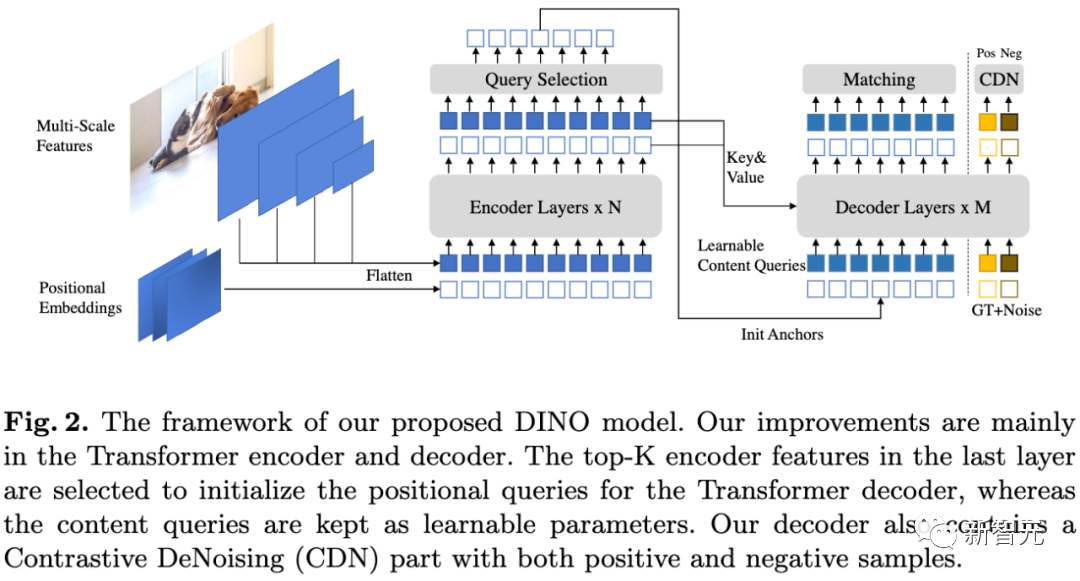
The training of deep learning models usually adopts a data-driven approach, by inputting large-scale data and learning in a self-supervised manner
Among the basic vision models, the DINO model shows surprising emergence capabilities. ViTs can recognize explicit semantic segmentation information even without supervised segmentation training. The DINO model with self-supervised Transformer architecture performs well in this regard
Follow-up work has studied how to utilize this segmentation information in the DINO model and perform it in downstream tasks such as segmentation and detection. etc. have achieved state-of-the-art performance, and some work has also proven that the penultimate layer features in ViTs trained with DINO are strongly related to the salience information in the visual input, such as distinguishing foreground, background and object boundaries, thereby improving image segmentation and other task performance.
In order to highlight the segmentation attributes, DINO needs to skillfully combine self-supervised learning, knowledge distillation and weight averaging methods during the training process
It is unclear whether each component introduced in DINO is essential for the emergence of segmentation masks. Although DINO also adopts the ViT architecture as its backbone, in the ordinary supervised ViT model trained on the classification task, and No segmentation emergent behavior was observed.
The emergence of CRATE
Based on the successful case of DINO, researchers want to explore complex self-supervised learning Is the pipeline necessary to obtain emergent properties in Transformer-like visual models?
The researchers believe that a promising way to promote segmentation properties in Transformer models is to design the Transformer model architecture taking into account the input data structure, which also represents representation learning. A combination of classic methods and modern data-driven deep learning frameworks.
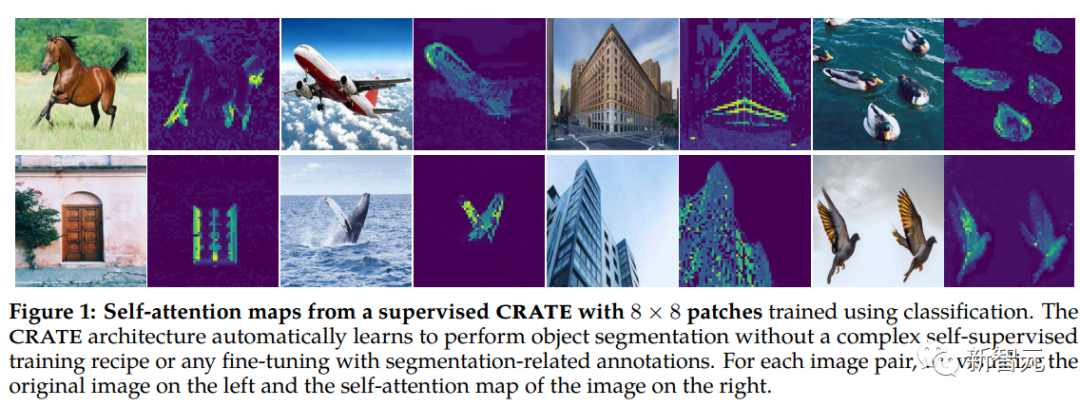
Compared with the current mainstream Transformer model, this design method can also be called a white-box Transformer model.
Based on the previous work of Professor Ma Yi’s group, researchers conducted extensive experiments on the CRATE model with a white-box architecture, proving that CRATE’s white-box design is the reason for the emergence of segmentation attributes in self-attention graphs.
What needs to be rephrased is: Qualitative assessment
The researcher uses the [CLS] token-based attention Strive to explain and visualize the model using the graph method and find that the query-key-value matrices in CRATE are all the same
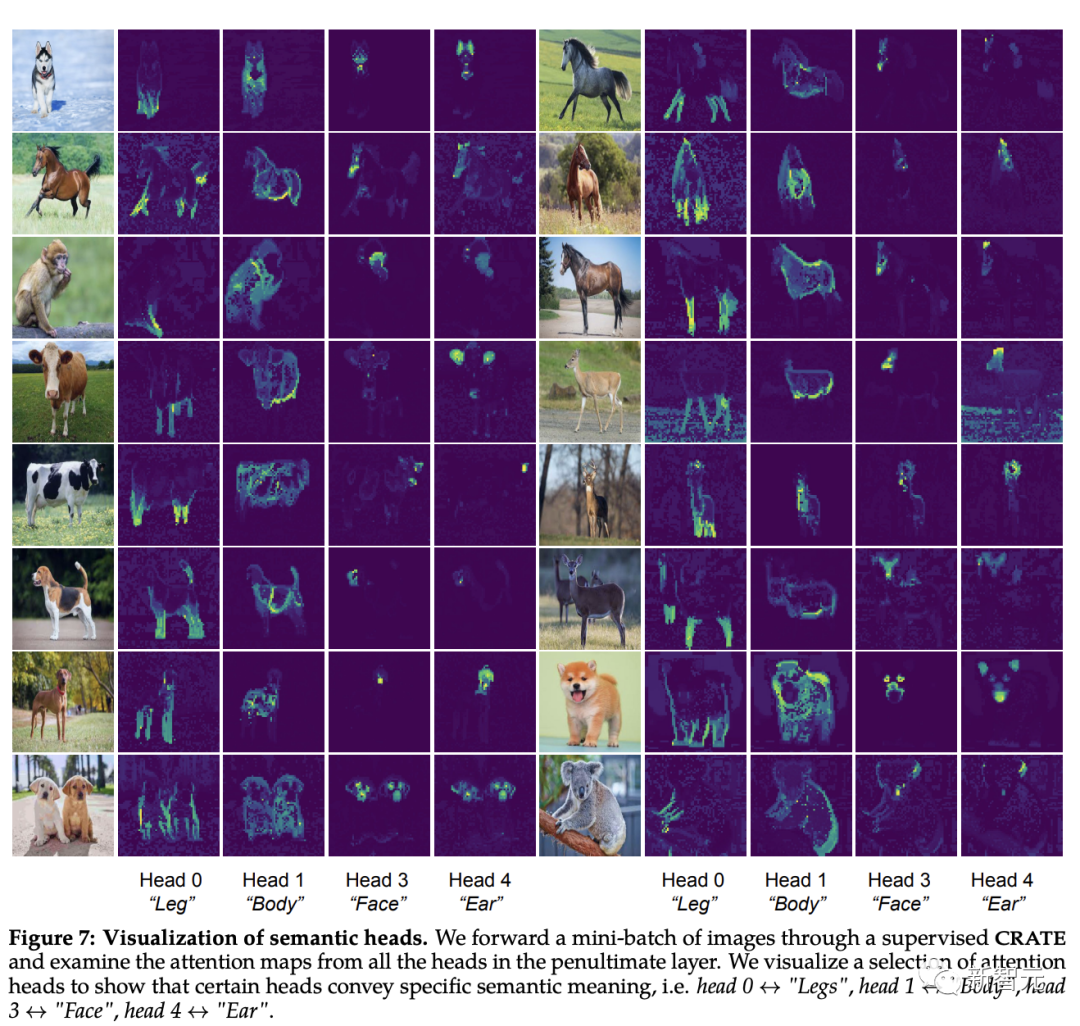
The CRATE model can be observed The self-attention map can correspond to the semantics of the input image. The internal network of the model performs clear semantic segmentation on each image, achieving an effect similar to the DINO model.
Ordinary ViT does not show similar segmentation properties when trained on supervised classification tasks
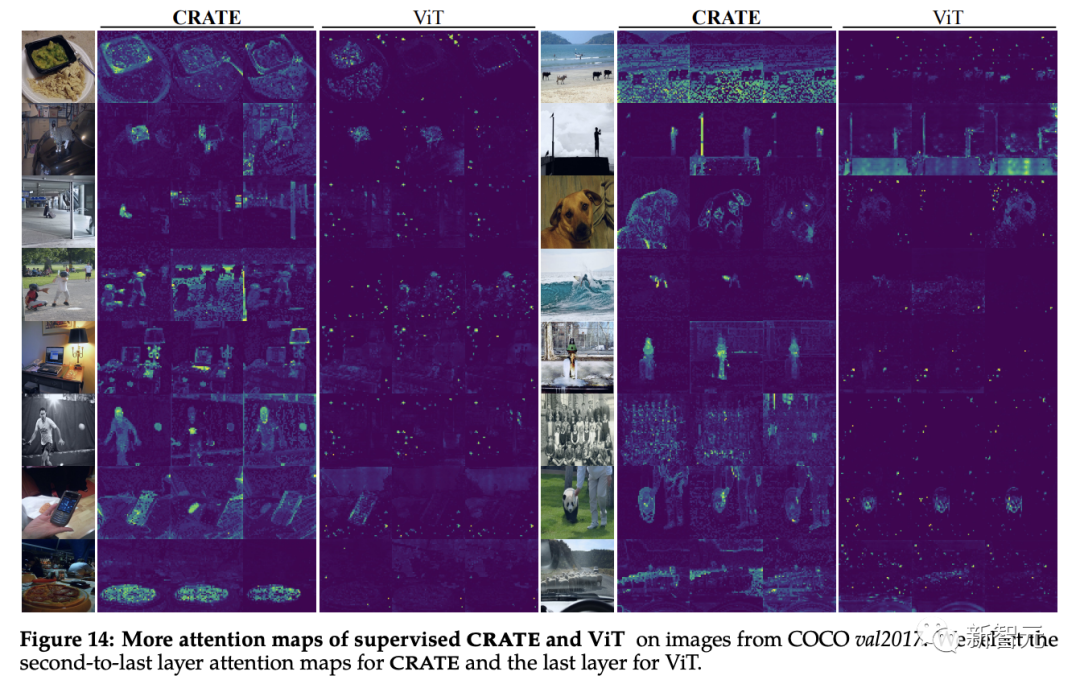
Based on previous research on visual image learning of block-by-block deep features, researchers conducted principal component analysis (PCA) research on deep token representations of CRATE and ViT models
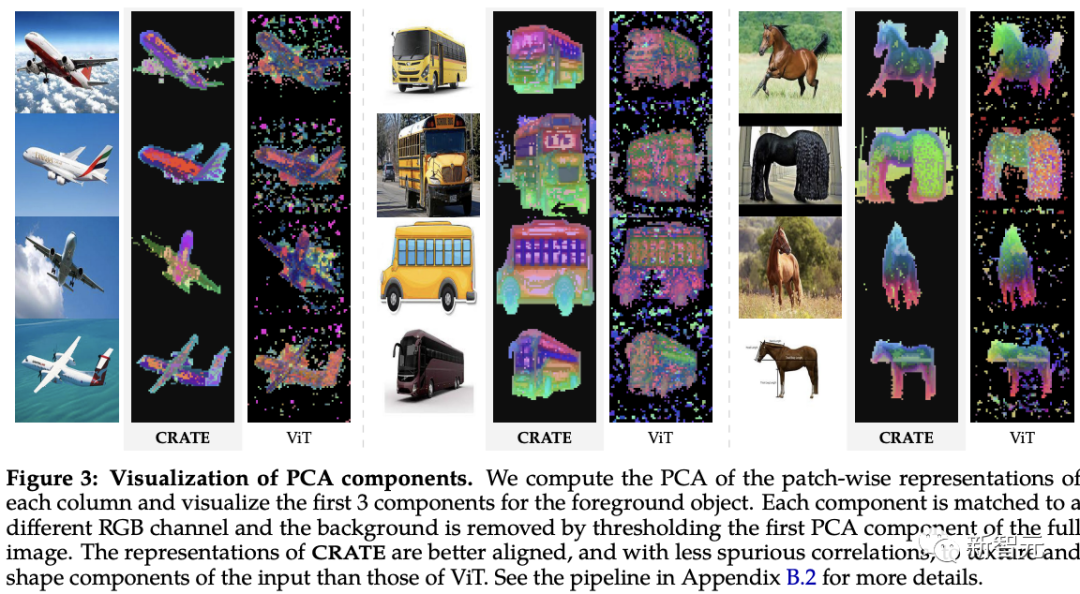
It can be found that CRATE can still capture the boundaries of objects in the image without segmentation supervision training.
Moreover, the principal components also indicate the feature alignment of similar parts between the token and the object, such as the red channel corresponding to the horse’s leg
The degree of PCA visualization structure of the supervised ViT model is quite low.
Quantitative Evaluation
The researchers used existing segmentations to evaluate the CRATE emergent segmentation properties. and object detection technology
As can be seen from the self-attention map, CRATE explicitly captures object-level semantics with clear boundaries. In order to quantitatively measure the quality of segmentation, the researchers used self-attention to The attention map generates a segmentation mask and compares the standard mIoU (mean intersection-over-union ratio) with the real mask.

It can be seen from the experimental results that CRATE is significantly better than ViT in terms of visual and mIOU scores, which shows that the internal representation of CRATE is useful for generating segmentation masks. Mask tasks more efficiently
Object detection and fine-grained segmentation
To further validate and evaluate the rich semantics captured by CRATE Information, the researchers adopted MaskCut, an efficient object detection and segmentation method, to obtain an automated evaluation model without manual annotation, and can extract more fine-grained segmentation from images based on the token representation learned by CRATE.
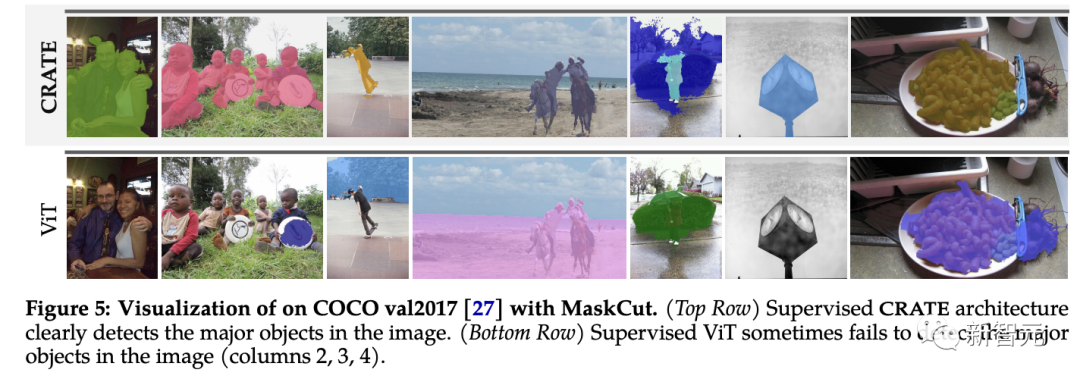
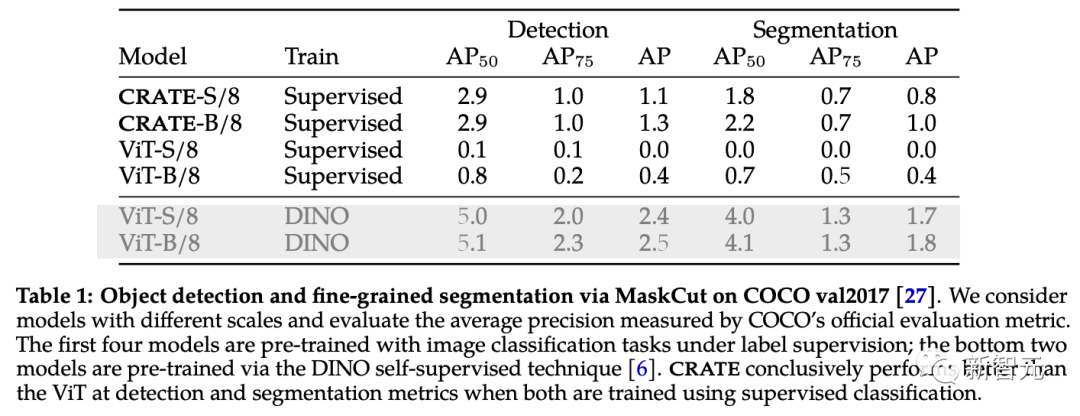
As you can see in the segmentation results on COCO val2017, there is an internal representation of CRATE in the detection and The segmentation index is better than that of supervised ViT. MaskCut with supervised ViT features cannot even produce segmentation masks at all in some cases.
White box analysis of CRATE’s segmentation capabilities
The role of depth in CRATE
The design of each layer of CRATE follows the same conceptual purpose: to optimize sparse rate reduction and transform token distribution into a compact and structured form. After rewriting: The design of each level of CRATE follows the same philosophy: optimize the reduction of sparse rate, and transform the distribution of tokens into a compact and structured form
Assume CRATE The emergence of semantic segmentation capabilities is similar to "representing clusters of tokens belonging to similar semantic categories in Z". It is expected that CRATE's segmentation performance can improve with increasing depth.
To test this, the researchers used the MaskCut pipeline to quantitatively evaluate segmentation performance across internal representations across different layers; and also applied PCA visualization to understand how segmentation emerges with depth. .
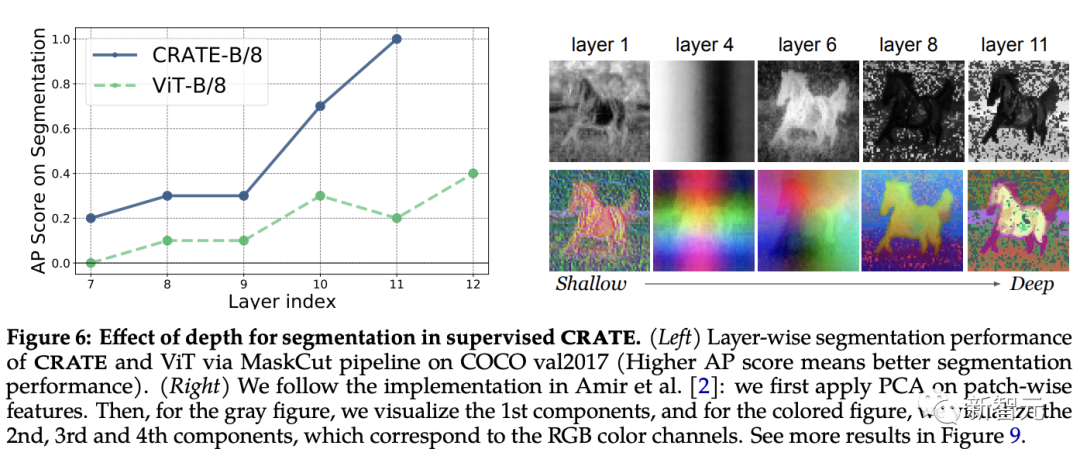
It can be observed from the experimental results that the segmentation score improves when using representations from deeper layers, which is very consistent with CRATE’s incremental optimization design.
In contrast, even though the performance of ViT-B/8 improves slightly in later layers, its segmentation scores are significantly lower than CRATE. The PCA results show that deep extraction from CRATE The representation will gradually pay more attention to foreground objects and be able to capture texture-level details.
melting experiment in CRATE
Attention block (MSSA) in CRATE and The MLP block (ISTA) is different from the attention block in ViT
To study the impact of each component on the emergent segmentation properties of CRATE, the researchers selected three CRATE variants: CRATE, CRATE-MHSA, CRATE-MLP. These variants represent the attention block (MHSA) and the MLP block in ViT respectively
The researchers applied the same pre-training settings on the ImageNet-21k dataset and then applied coarse segmentation evaluation and mask segmentation evaluation to quantitatively compare the performance of different models.

According to experimental results, CRATE significantly outperforms other model architectures in all tasks. It is worth noting that although the architectural difference between MHSA and MSSA is small, simply replacing MHSA in ViT with MSSA in CRATE can significantly improve ViT's coarse segmentation performance (i.e. VOC Seg). Performance. This further proves the effectiveness of white-box design
The content that needs to be rewritten is: pay attention to the identification of the semantic attributes of the header
[CLS] The self-attention map between the token and the image block token can see a clear segmentation mask. According to intuition, each attention head should be able to capture some features of the data.
The researchers first input the image into the CRATE model, and then had a human inspect and select four attention heads that seemed to have semantic meaning; then they used these attention heads on other input images. Self-attention map visualization on the head.
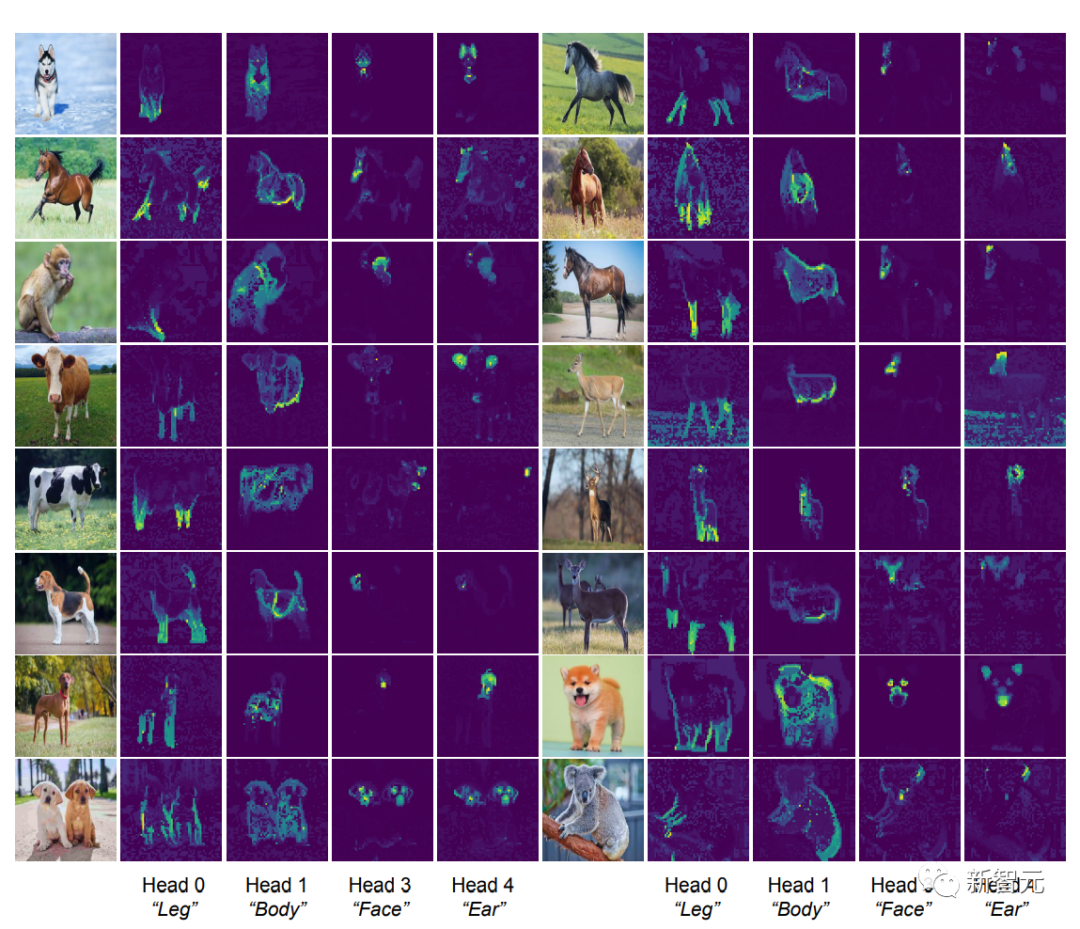
Observation can be found that each attention head can capture different parts of the object, and even different semantics. For example, the attention head in the first column can capture the legs of different animals, while the attention head in the last column can capture the ears and head
Since it is deformable This ability to parse visual input into part-whole hierarchies has been a goal of recognition architecture since the release of deformable part models and capsule networks, and the CRATE model of white-box design also has this ability.
The above is the detailed content of Professor Ma Yi's new work: White-box ViT successfully achieves 'partitioned emergence', is the era of empirical deep learning coming to an end?. For more information, please follow other related articles on the PHP Chinese website!

Hot AI Tools

Undresser.AI Undress
AI-powered app for creating realistic nude photos

AI Clothes Remover
Online AI tool for removing clothes from photos.

Undress AI Tool
Undress images for free

Clothoff.io
AI clothes remover

AI Hentai Generator
Generate AI Hentai for free.

Hot Article

Hot Tools

Notepad++7.3.1
Easy-to-use and free code editor

SublimeText3 Chinese version
Chinese version, very easy to use

Zend Studio 13.0.1
Powerful PHP integrated development environment

Dreamweaver CS6
Visual web development tools

SublimeText3 Mac version
God-level code editing software (SublimeText3)

Hot Topics
 The world's most powerful open source MoE model is here, with Chinese capabilities comparable to GPT-4, and the price is only nearly one percent of GPT-4-Turbo
May 07, 2024 pm 04:13 PM
The world's most powerful open source MoE model is here, with Chinese capabilities comparable to GPT-4, and the price is only nearly one percent of GPT-4-Turbo
May 07, 2024 pm 04:13 PM
Imagine an artificial intelligence model that not only has the ability to surpass traditional computing, but also achieves more efficient performance at a lower cost. This is not science fiction, DeepSeek-V2[1], the world’s most powerful open source MoE model is here. DeepSeek-V2 is a powerful mixture of experts (MoE) language model with the characteristics of economical training and efficient inference. It consists of 236B parameters, 21B of which are used to activate each marker. Compared with DeepSeek67B, DeepSeek-V2 has stronger performance, while saving 42.5% of training costs, reducing KV cache by 93.3%, and increasing the maximum generation throughput to 5.76 times. DeepSeek is a company exploring general artificial intelligence
 KAN, which replaces MLP, has been extended to convolution by open source projects
Jun 01, 2024 pm 10:03 PM
KAN, which replaces MLP, has been extended to convolution by open source projects
Jun 01, 2024 pm 10:03 PM
Earlier this month, researchers from MIT and other institutions proposed a very promising alternative to MLP - KAN. KAN outperforms MLP in terms of accuracy and interpretability. And it can outperform MLP running with a larger number of parameters with a very small number of parameters. For example, the authors stated that they used KAN to reproduce DeepMind's results with a smaller network and a higher degree of automation. Specifically, DeepMind's MLP has about 300,000 parameters, while KAN only has about 200 parameters. KAN has a strong mathematical foundation like MLP. MLP is based on the universal approximation theorem, while KAN is based on the Kolmogorov-Arnold representation theorem. As shown in the figure below, KAN has
 Hello, electric Atlas! Boston Dynamics robot comes back to life, 180-degree weird moves scare Musk
Apr 18, 2024 pm 07:58 PM
Hello, electric Atlas! Boston Dynamics robot comes back to life, 180-degree weird moves scare Musk
Apr 18, 2024 pm 07:58 PM
Boston Dynamics Atlas officially enters the era of electric robots! Yesterday, the hydraulic Atlas just "tearfully" withdrew from the stage of history. Today, Boston Dynamics announced that the electric Atlas is on the job. It seems that in the field of commercial humanoid robots, Boston Dynamics is determined to compete with Tesla. After the new video was released, it had already been viewed by more than one million people in just ten hours. The old people leave and new roles appear. This is a historical necessity. There is no doubt that this year is the explosive year of humanoid robots. Netizens commented: The advancement of robots has made this year's opening ceremony look like a human, and the degree of freedom is far greater than that of humans. But is this really not a horror movie? At the beginning of the video, Atlas is lying calmly on the ground, seemingly on his back. What follows is jaw-dropping
 AI subverts mathematical research! Fields Medal winner and Chinese-American mathematician led 11 top-ranked papers | Liked by Terence Tao
Apr 09, 2024 am 11:52 AM
AI subverts mathematical research! Fields Medal winner and Chinese-American mathematician led 11 top-ranked papers | Liked by Terence Tao
Apr 09, 2024 am 11:52 AM
AI is indeed changing mathematics. Recently, Tao Zhexuan, who has been paying close attention to this issue, forwarded the latest issue of "Bulletin of the American Mathematical Society" (Bulletin of the American Mathematical Society). Focusing on the topic "Will machines change mathematics?", many mathematicians expressed their opinions. The whole process was full of sparks, hardcore and exciting. The author has a strong lineup, including Fields Medal winner Akshay Venkatesh, Chinese mathematician Zheng Lejun, NYU computer scientist Ernest Davis and many other well-known scholars in the industry. The world of AI has changed dramatically. You know, many of these articles were submitted a year ago.
 Google is ecstatic: JAX performance surpasses Pytorch and TensorFlow! It may become the fastest choice for GPU inference training
Apr 01, 2024 pm 07:46 PM
Google is ecstatic: JAX performance surpasses Pytorch and TensorFlow! It may become the fastest choice for GPU inference training
Apr 01, 2024 pm 07:46 PM
The performance of JAX, promoted by Google, has surpassed that of Pytorch and TensorFlow in recent benchmark tests, ranking first in 7 indicators. And the test was not done on the TPU with the best JAX performance. Although among developers, Pytorch is still more popular than Tensorflow. But in the future, perhaps more large models will be trained and run based on the JAX platform. Models Recently, the Keras team benchmarked three backends (TensorFlow, JAX, PyTorch) with the native PyTorch implementation and Keras2 with TensorFlow. First, they select a set of mainstream
 Time Series Forecasting NLP Large Model New Work: Automatically Generate Implicit Prompts for Time Series Forecasting
Mar 18, 2024 am 09:20 AM
Time Series Forecasting NLP Large Model New Work: Automatically Generate Implicit Prompts for Time Series Forecasting
Mar 18, 2024 am 09:20 AM
Today I would like to share a recent research work from the University of Connecticut that proposes a method to align time series data with large natural language processing (NLP) models on the latent space to improve the performance of time series forecasting. The key to this method is to use latent spatial hints (prompts) to enhance the accuracy of time series predictions. Paper title: S2IP-LLM: SemanticSpaceInformedPromptLearningwithLLMforTimeSeriesForecasting Download address: https://arxiv.org/pdf/2403.05798v1.pdf 1. Large problem background model
 FisheyeDetNet: the first target detection algorithm based on fisheye camera
Apr 26, 2024 am 11:37 AM
FisheyeDetNet: the first target detection algorithm based on fisheye camera
Apr 26, 2024 am 11:37 AM
Target detection is a relatively mature problem in autonomous driving systems, among which pedestrian detection is one of the earliest algorithms to be deployed. Very comprehensive research has been carried out in most papers. However, distance perception using fisheye cameras for surround view is relatively less studied. Due to large radial distortion, standard bounding box representation is difficult to implement in fisheye cameras. To alleviate the above description, we explore extended bounding box, ellipse, and general polygon designs into polar/angular representations and define an instance segmentation mIOU metric to analyze these representations. The proposed model fisheyeDetNet with polygonal shape outperforms other models and simultaneously achieves 49.5% mAP on the Valeo fisheye camera dataset for autonomous driving
 Tesla robots work in factories, Musk: The degree of freedom of hands will reach 22 this year!
May 06, 2024 pm 04:13 PM
Tesla robots work in factories, Musk: The degree of freedom of hands will reach 22 this year!
May 06, 2024 pm 04:13 PM
The latest video of Tesla's robot Optimus is released, and it can already work in the factory. At normal speed, it sorts batteries (Tesla's 4680 batteries) like this: The official also released what it looks like at 20x speed - on a small "workstation", picking and picking and picking: This time it is released One of the highlights of the video is that Optimus completes this work in the factory, completely autonomously, without human intervention throughout the process. And from the perspective of Optimus, it can also pick up and place the crooked battery, focusing on automatic error correction: Regarding Optimus's hand, NVIDIA scientist Jim Fan gave a high evaluation: Optimus's hand is the world's five-fingered robot. One of the most dexterous. Its hands are not only tactile





